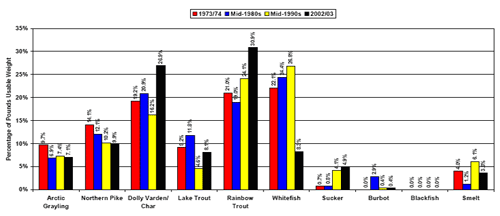|
Subsistence Fisheries
 |
Salmon Harvest
Subsistence fishing figures prominently in Bristol Bay communities. Athabaskan, Aleut, and Yup’ik peoples of Bristol Bayannually harvest about 150 thousand salmon which they eat fresh and dry, smoke, salt, pickle, can and store for winter sustenance, as they have for thousands of years. All 5 species of salmon are used, but Chinook, coho and sockeye salmon are the most popular food resource and comprise 60% to 80% of annual subsistence harvests (Fall et al. 1996, Fall et al. 2006; ADFG 2008).
|




|
Non-Salmon Subsistence Fish Harvest in Bristol Bay
Freshwater fish provide rural residents of Bristol Bay year-round subsistence opportunities, in contrast to salmon, which are captured only during specific time frames in summer and fall. For example, in the Kvichak watershed (Figure 1) 70 – 100% of rural households annually harvest 18,000 to 50,000 usable pounds of non-salmon fish to supplement their diets (Figure 2).
 |
| Figure 1. Villages and communities of the Kvichak River watershed; 70% to100% of households in these communities annually harvest from 18,000 to 50,000 pounds of non-salmon fish to supplement their diets. Click on image for a larger view. |
Humpback whitefish (Coregonus pidschian), Dolly Varden, (Salvelinus malma), and rainbow trout (Oncorhynchus mykiss) are important subsistence foods and the importance of a particular species to a community is generally related to its local availability (Figure 3). In Nondalton (Figure 1), whitefish are abundant during early spring through summer and about 75% of households participate in their harvest (Morris 1986, Stickman et al. 2003). Humpback whitefish are harvested using gillnets set under ice where springs feed into local lakes, or by ice fishing using single hooks baited with fish eggs. In the Lake Iliamna area, humpback whitefish are harvested with gillnets in fall and supply the largest non-salmon fish harvest in the community of Igiugig (Figure 1) providing food for residents of the region through a resource exchange network among villages (Morris 1986, Fall et al. 1996).
 |
| Figure 2. Estimated subsistence harvest of non-salmon freshwater fish in pounds useable weight per person, Kvichak River watershed, Bristol Bay Alaska. Graph from Krieg et al. 2005. Click on image for a larger view. |
 |
| Figure 3. Percent composition of the total non-salmon freshwater fish subsistence harvest in the Kvichak River watershed which ranges from 18,000 to 50,000 pounds per household per year (graph from Krieg et al. 2005). Note importance of Dolly Varden, rainbow trout, and whitefish to harvest in rural communities. Click on image for a larger view. |
Little scientific data are available on non-salmon fish life history, genetics, migration patterns, and essential habitats used for spawning, rearing, overwintering, or migration in the Bristol Bay region, although these species are an important year-round protein resource for local subsistence users. For example, it is unclear if humpback whitefish or Dolly Varden in the area migrate to saltwater habitats for part of their life cycle. Studies of whitefish earbones or otoliths do not show a clear pattern of saltwater use (This dearth of information on essential habitat use by fish throughout Alaska makes informed development decisions relative to fish conservation difficult.
The Nushagak and Kvichak River watersheds are the largest in Bristol Bay and they provide essential spawning, incubation and rearing habitats for five species of Pacific salmon and at least 14 resident fish species (Table 1).
 |
| Figure 4. Composition of non-salmon freshwater fish harvest, by decade in villages of the Kvichak River watershed, Bristol Bay, Alaska. Graph from Krieg et al. 2005. Click on image for a larger view. |
Table 1. Common and scientific names of fish species known to occur in the Nushagak and Kvichak River watersheds, Bristol Bay, Alaska.
Common name |
Scientific name |
| Anadromous Salmon |
|
| sockeye salmon |
Oncorhynchus nerka |
| Chinook salmon |
Oncorhynchus tshawytscha |
| coho salmon |
Oncorhynchus kisutch |
| pink salmon |
Oncorhynchus gorbuscha |
| chum salmon |
Oncorhynchus keta |
| Resident Fish |
|
| longnose sucker |
Catostomus catostomus |
| northern pike |
Esox lucius |
| least cisco |
Coregonus sardinella |
| broad whitefish |
Coregonus nasus |
| humpback whitefish |
Coregonus pidschian |
| round whitefish |
Prosopium cylindraceum |
| Arctic grayling |
Thymallus arcticus |
| lake trout |
Salvelinus namaycush |
| Arctic char |
Salvelinus alpinus |
| Dolly Varden |
Salvelinus malma |
| rainbow trout |
Oncorhynchus mykiss |
| burbot |
Lota lota |
| threespine stickleback |
Gasterosteus aculeatus |
| ninespine stickleback |
Pungitius pungitius |
| slimy sculpin |
Cottus cognatus |
|
References
ADF&G 2007 Report (pdf file 1.95 mb)
ADFG (Alaska Department of Fish and Game). 2008. 2008 Bristol Bay Area Management Report. Fishery Management Report 09-30. Alaska Department of Fish and Game, Anchorage, AK.
Fall, J.A., D.L. Holen, B. Davis, T. Krieg, and D. Koster. 2006. Subsistence harvests and uses of wild resources in Iliamna, Newhalen, Nondalton, Pedro Bay, and Port Alsworth, Alaska, 2004. Alaska Department of Fish and Game, Division of Subsistence Technical Paper No. 302. Juneau.
Fall, J. A., M. B. Chythlook, J. C. Schichnes, and J. M. Morris. 1996. An overview of the harvest and use of freshwater fish by the communities of the Bristol Bay region, southwest Alaska. Alaska Department of Fish and Game, Division of Subsistence, Technical Paper Series. Technical Paper No. 166, 171 p.

|










